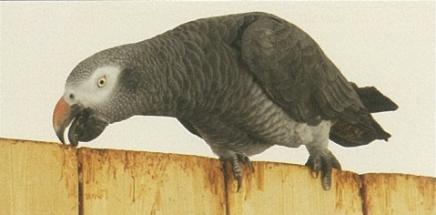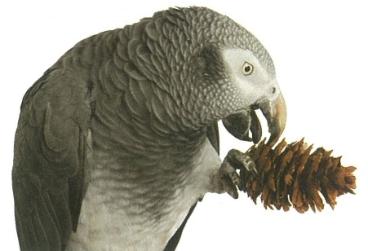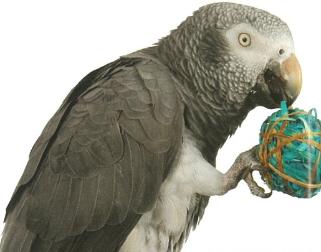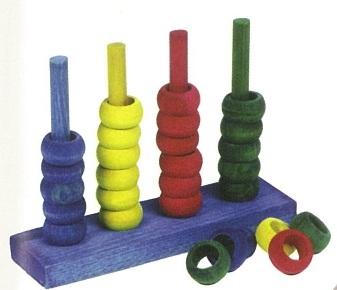As wild birds, greys are kept quite busy by chewing on wood, leaves, buds and flowers as they search for food in the trees. Despite the fact that they usually have food available at all times, pet greys will still try to replicate this behaviour in the home environment and this is quite normal. If the bird does not have access to suitable things to chew, he is very likely to start chewing anything he can get his beak into including your furniture, doors and ornaments.
So it is important to provide your bird with destructible toys to keep him busy. While you can certainly buy these from parrot stores, you can also make up your own. Try using clothes pegs (remove the spring), pieces of hardwood such as oak, apple, cherry, hazel etc., cardboard, newspaper, pine cones, rawhide leather strips, or short lengths of cord made from natural fibres such as cotton, hemp or jute. Also, providing your bird with opportunities to forage for some of his favourite foods hidden in puzzle toys will help to divert him from chewing unsuitable objects. Again, you can get these toys from pet product suppliers or devise your own versions. Greys will soon learn to search out food treats hidden in pieces of crumpled newspaper inserted into cardboard tubes.
So it is important to provide your bird with destructible toys to keep him busy. While you can certainly buy these from parrot stores, you can also make up your own. Try using clothes pegs (remove the spring), pieces of hardwood such as oak, apple, cherry, hazel etc., cardboard, newspaper, pine cones, rawhide leather strips, or short lengths of cord made from natural fibres such as cotton, hemp or jute. Also, providing your bird with opportunities to forage for some of his favourite foods hidden in puzzle toys will help to divert him from chewing unsuitable objects. Again, you can get these toys from pet product suppliers or devise your own versions. Greys will soon learn to search out food treats hidden in pieces of crumpled newspaper inserted into cardboard tubes.
Noise
Unlike most other parrots, greys are not usually noisy birds. However, if your bird does start to make a loud repetitive sound, this is usually because he is short of attention and bored. Birds which spend too long in their cages will be prone to this behaviour, so they just need to be out more and be kept occupied. When a bird has plenty of time out of the cage but also starts to make a loud noise which causes a problem, it is vital that you do not inadvertently 'reward' the bird by giving him any attention, even by saying 'No' to him. Here, the most effective solution to such a noise problem is for you, and everyone else, simply to leave the room each time your bird starts to produce the unwanted noise. Eventually, most birds realise that their behaviour has caused you to leave him. When he makes this connection he will have an incentive to stop making the unwanted noise.
When not supervised, greys may chew
woodwork, such as doors and items of furniture.
woodwork, such as doors and items of furniture.

Chew-toys can be fabricated from natural items,
like pine cones above, or be bought from pet shops,
like this straw chew ball in the picture below.
like pine cones above, or be bought from pet shops,
like this straw chew ball in the picture below.

If greys are allowed to hear loud noises or swearing
repeatedly they may start to mimic these
sounds, so take care of what your bird hears.
repeatedly they may start to mimic these
sounds, so take care of what your bird hears.

A grey with straw chew ball.

This chew-toy is made from natural fibres and
is ideal for greys. Make sure that you introduce
all new toys carefully - your bird should see you
playing with them on several occasions before
they are placed inside his cage.
is ideal for greys. Make sure that you introduce
all new toys carefully - your bird should see you
playing with them on several occasions before
they are placed inside his cage.

Toys with removable parts often interest a bird
more than static, fixed toys.
more than static, fixed toys.